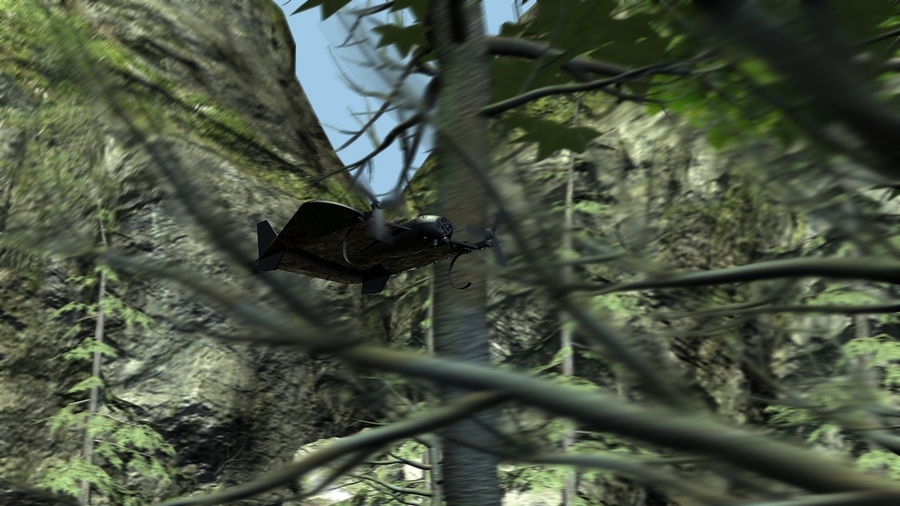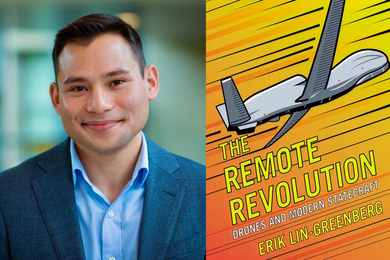Despite their reputation as urban pests, pigeons traverse the city skies with grace and agility, dodging buildings, lampposts, power lines and other obstacles while traveling at remarkably high speeds. A multidisciplinary university research initiative (MURI) led by Computer Science and Artificial Intelligence Laboratory Associate Professor Russ Tedrake will bring together a diverse group of researchers to develop a bird-sized, unmanned aerial vehicle (UAV), thanks to an Office of Naval Research Grant. The vehicle will be capable of navigating both urban and forest environments using vision-based control.
The $7.5 million grant funds five years of research into creating high-speed, state of the art UAVs capable of handling aerodynamic disturbances and armed with extreme maneuverability.
“UAVs are currently not reaching their full flying potential,” Tedrake says. “They’re flying conservatively, like large planes. We want to create a UAV that can fly through a crowded environment and fly well despite complicated air flow.”
The MURI brings together seven principal investigators working in the fields of biology, machine vision, planning and control and UAVs, led by Tedrake. Team members include: Emilio Frazzoli (MIT), William Freeman (MIT), J. Andrew Bagnell (CMU), Andrew Biewener (Harvard), Martial Hebert (CMU), Yann LeCun (NYU) and David Lentink (Wageningen University).
Researchers are aiming to develop a UAV with a 24-inch wingspan, capable of flying between 5 and 15 meters per second, navigating dense urban and natural environments and perching like a bird. The project will draw from Tedrake’s work with both fixed and flap-winged UAVs, and with perching gliders.
“The control tools developed in the Robot Locomotion Group are well-suited to this problem, and will showcase the types of control design we do here,” Tedrake says.
The UAV, which will be modeled, in part, on the results of extensive study into bird flight, will be a wingeron plane, meaning that the plane’s wings will be able to rotate fully for maximum maneuverability.
Researchers at CSAIL will be focused on building the actual planes and designing the machine’s control system, which will utilize Freeman’s work with image deblurring, allowing the plane’s vision-based control system to distinguish obstacles and targets while traveling at high speeds.
The $7.5 million grant funds five years of research into creating high-speed, state of the art UAVs capable of handling aerodynamic disturbances and armed with extreme maneuverability.
“UAVs are currently not reaching their full flying potential,” Tedrake says. “They’re flying conservatively, like large planes. We want to create a UAV that can fly through a crowded environment and fly well despite complicated air flow.”
The MURI brings together seven principal investigators working in the fields of biology, machine vision, planning and control and UAVs, led by Tedrake. Team members include: Emilio Frazzoli (MIT), William Freeman (MIT), J. Andrew Bagnell (CMU), Andrew Biewener (Harvard), Martial Hebert (CMU), Yann LeCun (NYU) and David Lentink (Wageningen University).
Researchers are aiming to develop a UAV with a 24-inch wingspan, capable of flying between 5 and 15 meters per second, navigating dense urban and natural environments and perching like a bird. The project will draw from Tedrake’s work with both fixed and flap-winged UAVs, and with perching gliders.
“The control tools developed in the Robot Locomotion Group are well-suited to this problem, and will showcase the types of control design we do here,” Tedrake says.
The UAV, which will be modeled, in part, on the results of extensive study into bird flight, will be a wingeron plane, meaning that the plane’s wings will be able to rotate fully for maximum maneuverability.
Researchers at CSAIL will be focused on building the actual planes and designing the machine’s control system, which will utilize Freeman’s work with image deblurring, allowing the plane’s vision-based control system to distinguish obstacles and targets while traveling at high speeds.






